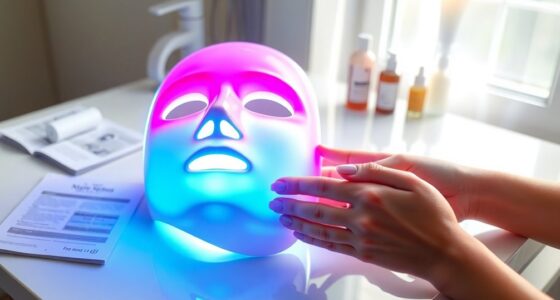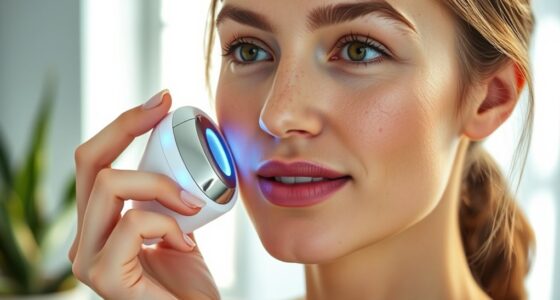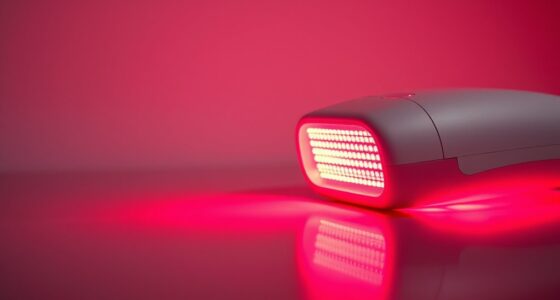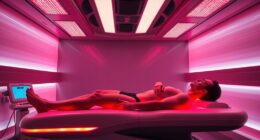Choosing whether to use red light therapy in the morning or at night depends on your goals and routine. Morning sessions energize your skin, boost circulation, and protect against daily environmental stressors, helping your skin look radiant all day. Night sessions support natural repair and collagen growth while you sleep, maximizing regeneration. Both times work well if you stay consistent. Want to learn how to optimize your routine for better results? Keep exploring to find out more.
Key Takeaways
- Morning therapy energizes skin and enhances resilience, preparing it for environmental stressors throughout the day.
- Nighttime use supports cellular repair and collagen synthesis during the body’s natural regeneration cycle.
- Consistent application at either time maximizes long-term collagen production and skin renewal benefits.
- Morning routines boost radiance, while evening routines promote deeper skin healing and inflammation reduction.
- The best timing depends on personal lifestyle, skincare goals, and integrating red light therapy into existing routines.
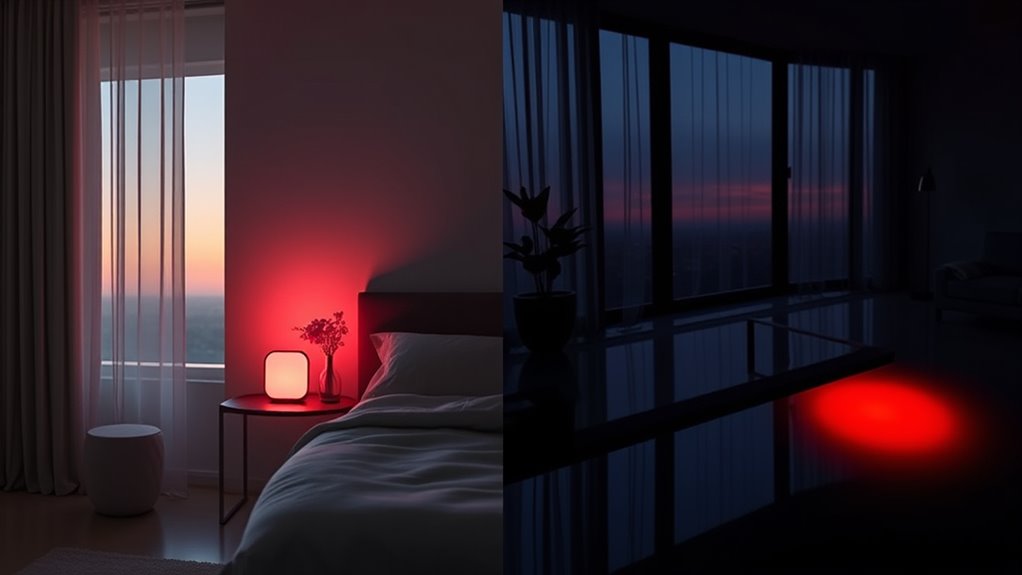
Deciding whether to use red light therapy for collagen production in the morning or at night can impact your skincare results. The timing matters because it influences how effectively your skin responds and how seamlessly it fits into your daily routines. If you’re aiming to maximize collagen synthesis, you’ll want to consider how red light therapy integrates with your overall skincare routines and sleep hygiene.
Using red light therapy in the morning can give your skin a boost to start the day. It energizes your skin cells, promotes circulation, and helps set a positive tone for your skincare routine. When you incorporate it into your morning rituals, you might notice your skin looking fresher and more radiant throughout the day. Plus, applying red light therapy in the morning can serve as a protective measure—enhancing your skin’s resilience against environmental stressors like pollution and UV exposure. Just confirm your skin is clean and dry before treatment, and follow up with moisturizers and sunscreens to lock in the benefits.
Morning red light therapy boosts skin’s radiance and resilience for the day ahead.
On the other hand, using red light therapy at night aligns well with your natural biological rhythms and sleep hygiene. During sleep, your body, including your skin, repairs and regenerates tissue, making it an ideal time to support collagen production. Red light therapy in the evening can enhance this process, promoting better cellular repair and helping to reduce inflammation that might have accumulated during the day. Incorporating it into your nighttime skincare routines can also make it easier to remember, as it becomes part of your wind-down process. Just be sure to avoid heavy creams or active ingredients that could interfere with light absorption. This approach can lead to a more relaxed, restorative skincare experience, supporting your skin’s natural renewal cycle. Additionally, choosing the appropriate light wavelength can further improve the effectiveness of this therapy.
Ultimately, your choice depends on your lifestyle and preferences. If you prefer a morning boost and want to incorporate red light therapy into your active daytime skincare routines, doing it in the morning makes sense. If you prioritize skin repair and relaxation, nighttime use aligns better with your sleep hygiene and cellular regeneration. Whichever you choose, consistency is key. By sticking to a routine—morning or night—you’ll optimize collagen production over time. Remember, the effectiveness of red light therapy is enhanced when combined with good sleep hygiene and a detailed skincare routine, ensuring your skin gets the support it needs to look and feel its best.
Frequently Asked Questions
Can Red Light Therapy Improve Skin Elasticity Beyond Collagen Production?
Red light therapy can boost skin elasticity by promoting cellular rejuvenation and increasing skin hydration. It stimulates your cells to produce more collagen, which helps tighten and firm your skin. Beyond collagen, it enhances blood flow and improves overall skin health. By supporting these processes, red light therapy offers benefits that go beyond collagen production, leading to more resilient, hydrated, and youthful-looking skin over time.
Does Skin Type Affect the Effectiveness of Red Light Therapy Timing?
Imagine your skin’s like a delicate garden, sensitive to the sun’s rays and seasonal shifts. Your skin type, influenced by sensitivity and hormonal fluctuations, can influence how effective red light therapy is at different times. If you have sensitive skin, you might find it better to avoid intense sessions during hormonal highs. Adjusting timing based on your skin’s unique rhythm guarantees you nurture your glow effectively, like tending to a blooming garden.
Are There Any Side Effects From Using Red Light at Specific Times?
You might wonder if using red light at certain times causes side effects. Generally, red light therapy is safe, but some people could experience photo sensitivity, especially if they have sensitive skin. If you use it late at night, you might disrupt your sleep due to light exposure. To avoid issues, consider your skin’s sensitivity and try to use red light during times that won’t interfere with your sleep cycle.
How Long Should Each Red Light Session Last for Optimal Collagen Benefits?
Think of your red light session as watering a delicate plant; too little, and it won’t thrive, too much, and it risks overfeeding. For ideal timing, aim for 10-20 minutes per session. This duration maximizes collagen benefits without overstimulating your skin. Stick to this consistent session duration, whether morning or night, to give your skin the best chance to regenerate and glow.
Can Red Light Therapy Replace Other Anti-Aging Skincare Routines?
Red light therapy can complement your anti-aging treatments, but it shouldn’t replace your entire skincare routine. It’s a powerful addition that stimulates collagen production and improves skin texture, yet traditional skincare routines include cleansing, moisturizing, and sun protection that red light can’t replace. To maximize anti-aging benefits, combine red light therapy with your existing skincare routines, ensuring you get all-encompassing anti-aging care without relying solely on one method.
Conclusion
Ultimately, the best time to use red light therapy for collagen depends on your routine and skin goals. Some experts suggest morning use boosts circulation and prepares your skin for the day, while others believe nighttime application promotes repair and relaxation. Scientific evidence is still evolving, but consistency matters most. Try both times and see what works best for you—your skin might just respond better when you make red light a regular part of your daily routine.


